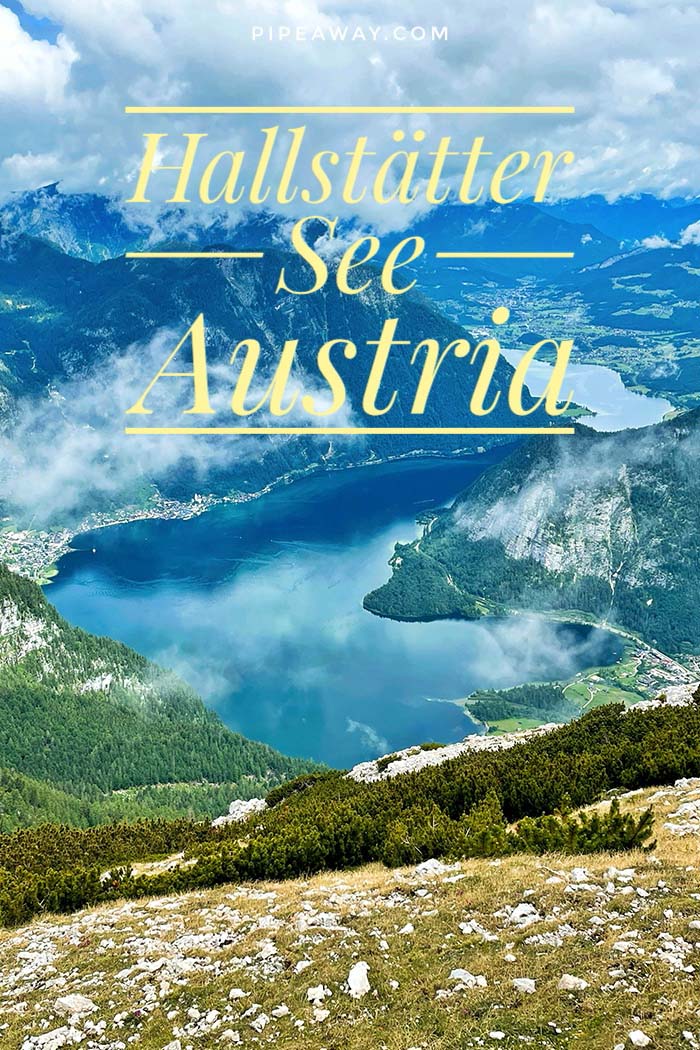When I recently detoured from the A10 autobahn, the fastest route from Salzburg to the southern Austrian region of Carinthia, it wasn’t because I got lost. It was because I knew what was waiting just a 70-minute scenic ride away from Mozart‘s birthplace. A lake so stunning, it regularly breaks Instagram. Hallstätter See or Lake Hallstatt is so appealing that it often becomes a case study in overtourism.
In the heart of Austria’s Salt Domain, Hallstätter See is supplying the beat
For thousands of years, the local economy here rested on salt. Some 75 kilometers southeast of Salzburg (translates to Salt Castle), Hallstatt or Salt Settlement is home to some of the oldest salt mines in the world.
The prehistoric sea that secured “white gold” as a shaping force of the region’s wealth is not around anymore. But Hallstätter See, a significantly tinier body of water, became a magnet for tourist dollars.
In the heart of Austria’s Salzkammergut region (Salt Domain), Hallstätter See is supplying the beat. Surrounded by towering alpine peaks, this UNESCO World Heritage Site offers a unique blend of natural beauty and cultural heritage.
Its shores shimmer as you take a boat ride across the lake’s crystal-clear waters. The landscape is dramatic, and the villages dotting the area are full of charm.
Indeed, it’s a feast for the eyes, a peaceful escape if you want that. On the other hand, outdoor adventures enable active holidays for restless spirits.
Get ready to explore Hallstätter See, a visual masterpiece in the Upper Austria Alps!
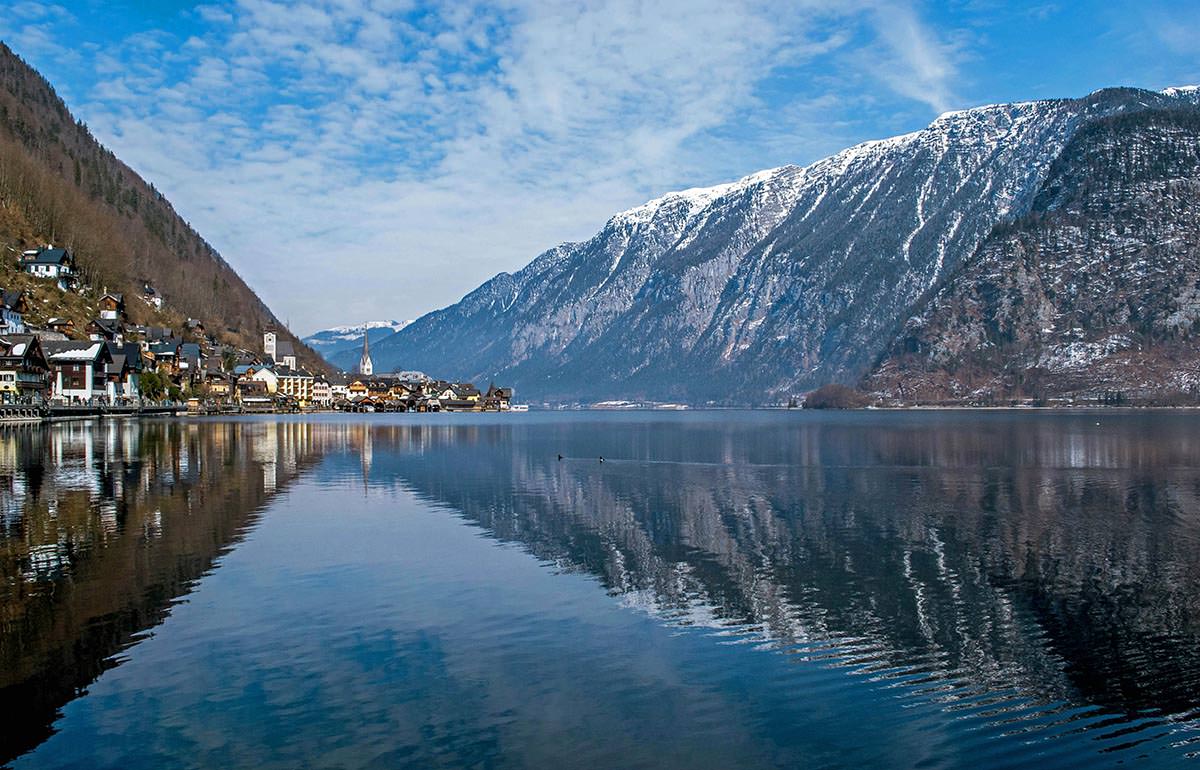
What to expect
Hallstätter See is a stunning expanse of water that reflects the surrounding mountains and sky like a mirror. On a calm day, its glassy surface is so still that it creates a perfect reflection of the imposing Dachstein range, adding to the surreal beauty of the landscape.
Whether viewed in the soft morning light, the golden hues of sunset, or under a dome of stars, the lake’s ever-changing appearance is a sight to behold.
The framing mountains provide a striking backdrop to the serene waters of Hallstätter See. Rugged peaks of the Dachstein Massif dominate the skyline. Lush, verdant forests blanket the lower slopes.
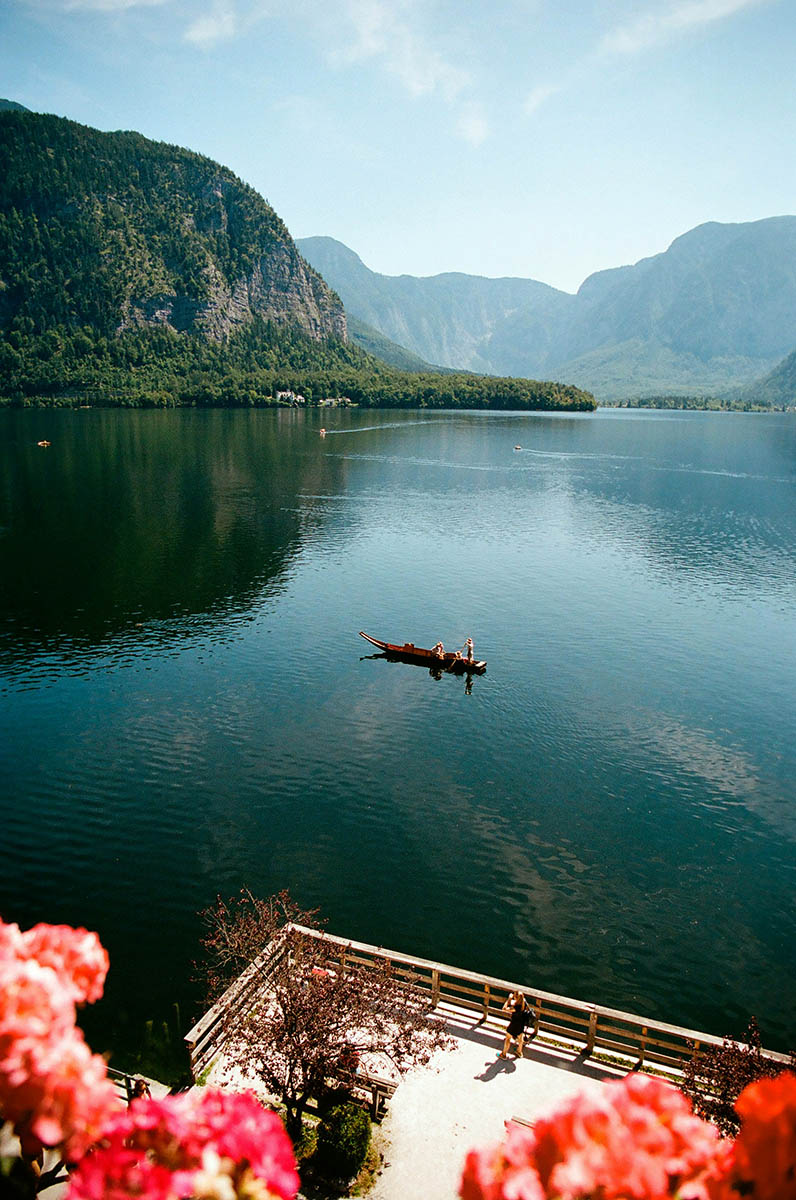
Each season brings its own unique charm, from the vibrant colors of autumn foliage to the snow cover in winter.
The picturesque villages on the shores of Hallstätter See add to its appeal.
Hallstatt, with its pastel-colored houses clinging to the mountainside, is often described as one of the most beautiful villages in the world. So beautiful, in fact, that China built its own Hallstatt clone on an artificial lake in Guangdong Province in 2012.
Ironically, the Chinese copy-paste boosted fame for the Austrian original, launching an avalanche of tourists to Hallstätter See shores. The situation with overtourism got so out of hand that the town once put up a wooden fence to discourage scenic spot selfies.
Still, Hallstatt remains charming with its cobblestone streets and the iconic lakeside steeple of the Evangelical Church. If you’re after similar postcard-perfect views but fewer crowds, head over to Obertraun, just across the lake. It offers a more laid-back atmosphere.
How deep is Hallstätter See?
Hallstätter See’s deepest point is at 125 meters (410 feet). That makes it one of Austria’s deeper alpine lakes. Hallstätter See underwater is deep enough to intrigue scuba divers, mystery lovers, and anyone who enjoys the idea of ancient secrets resting beneath still waters.
While modest in comparison to the lakes in the neighborhood, Hallstätter See’s size is still impressive. This glacially carved alpine lake covers approximately 8.5 square kilometers (or about 3.3 square miles). Nearly 8 kilometers long and more than 2 kilometers wide, its drama lies in how it’s set: narrow, deep, and hugged tightly by towering cliffs.
Certainly, Lake Hallstatt is big enough to paddle across, dive into, bike around, and still feel like there’s more to explore.
Hallstatt history
Hallstatt isn’t just a pretty place. It lent its name to an entire chunk of European prehistory: the Hallstatt Period, aka the early Iron Age (8th to 6th centuries BC). This little village became significant for adopting ironmaking, replacing cremation with burials, and developing trade networks.
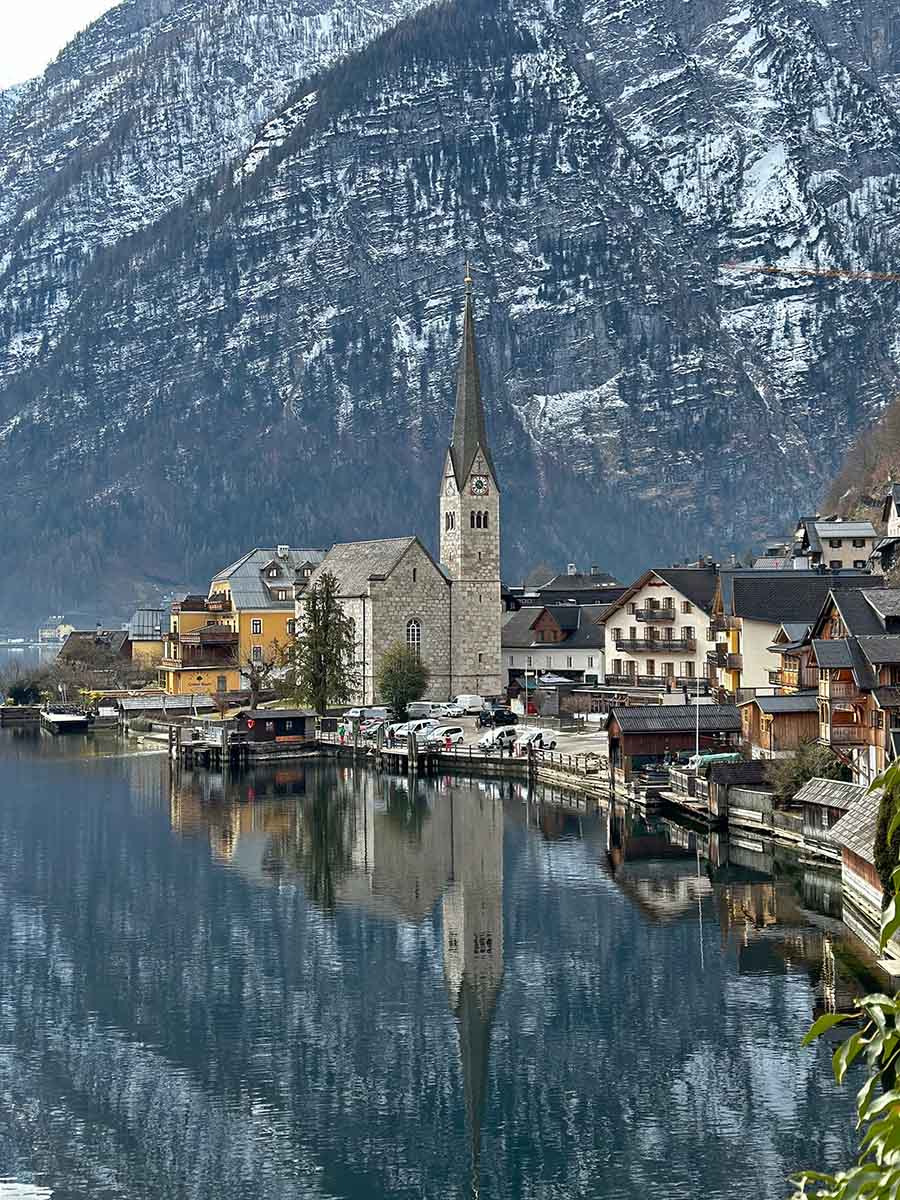
Hallstatt became the namesake of the culture because of the rich archeological finds at its cemetery and salt mines, which have been in operation for three millennia. Hallstatt Museum houses a collection of these discoveries.
If your interests lean toward the macabre, behind the Maria Himmelfahrt Church, there’s the Michaelskapelle (St. Michael’s Chapel), where half of the 1,200 displayed skulls are hand-painted. The coloring of bones at Beinhaus Hallstatt (one of the period’s charnel houses) was a direct consequence of the position of the cemetery, hemmed in by mountains and the lake. When space ran out, older graves were exhumed, and the painting ritual became a second farewell to long-past residents.
In 1997, the Hallstatt-Dachstein/Salzkammergut Cultural Landscape was recognized as a UNESCO World Heritage Site for its cultural and natural significance.

The same landscape has played the role of an artistic muse, too. The Hallstätter See and its surroundings have stirred the imaginations of countless artists, from writers like Adalbert Stifler and Franz Grillparzer, to notable painters of the Biedermeier and Romantic eras like Franz Steinfeld and Ferdinand Georg Waldmüller.
Top Things to Do at Hallstätter See
Exploring Hallstätter See offers a wealth of activities and attractions. Here are some ideas for your inspiration!
1. Hallstätter See swimming
Yes, you can swim in Hallstätter See! But be warned: Hallstätter See water temperature is on the cooler side, clocking in at refreshing 16–22°C (61–72°F) in summer.
Some of the best beaches around are Badeinsel Hallstatt (a bathing island near Hallstatt center), Strandbad Obertraun (a spacious bathing area with grassy lawns, shady trees, and barbecue facilities), and Strandbad Untersee (a playground-equipped beach on the lake’s northern shore).
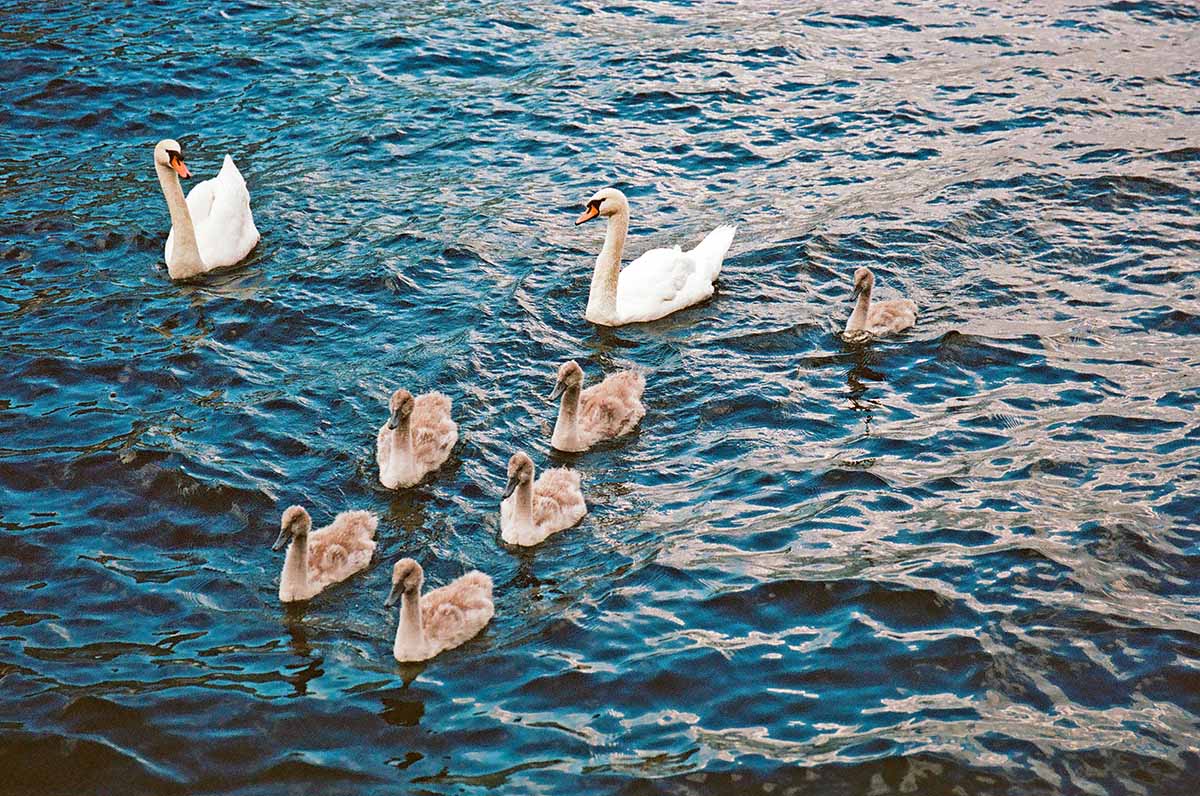
If you’re interested in bathing with a dog at Hallstätter See, a pet-friendly beach is Landbettler, between Hallstatt and Obertraun. Here, your four-legged companion can join in the splashy fun and even use a dog toilet.
There is also a dedicated FKK area at Hallstätter See. Since 1987, Obertraun’s Winkl district has had a lakeside stretch dedicated to nudists (north of the main beach area).
Strandbad Untersee also has a designated nudist zone.
2. Hallstätter See diving
Diving in Hallstätter See is kind of surreal. It’s not just clear water and curious fish in Lake Hallstatt (you’ll spot whitefish, brown trout, and pike, especially in September). This place offers a history-soaked plunge into one of Austria’s most fascinating alpine lakes.
During your underwater archaeology, you can explore sunken trees from the 5th century, preserved by cold, mineral-rich waters. Then there’s the wreck of the excursion ship Kronprinz Rudolf, or the wooden salt-transport ship Salzmützen. If you’re a diving couple, you can even exchange vows in Hallstätter See; there’s an underwater altar where you can gargle your “I do”.
While beginners can enjoy guided shallower areas, the Hallstätter See dive conditions are more suitable for intermediate and advanced divers. Water is cold year-round, so drysuits or thick wetsuits are standard kit. Visibility is often best in cooler months, unless there’s been a long spell of heavy rain.
Unfortunately, there are no diving centers on Hallstätter See. The closest scuba base for info, paperwork, and moral support is Tauchcenter Dachstein-Salzkammergut at nearby Lake Wolfgang.
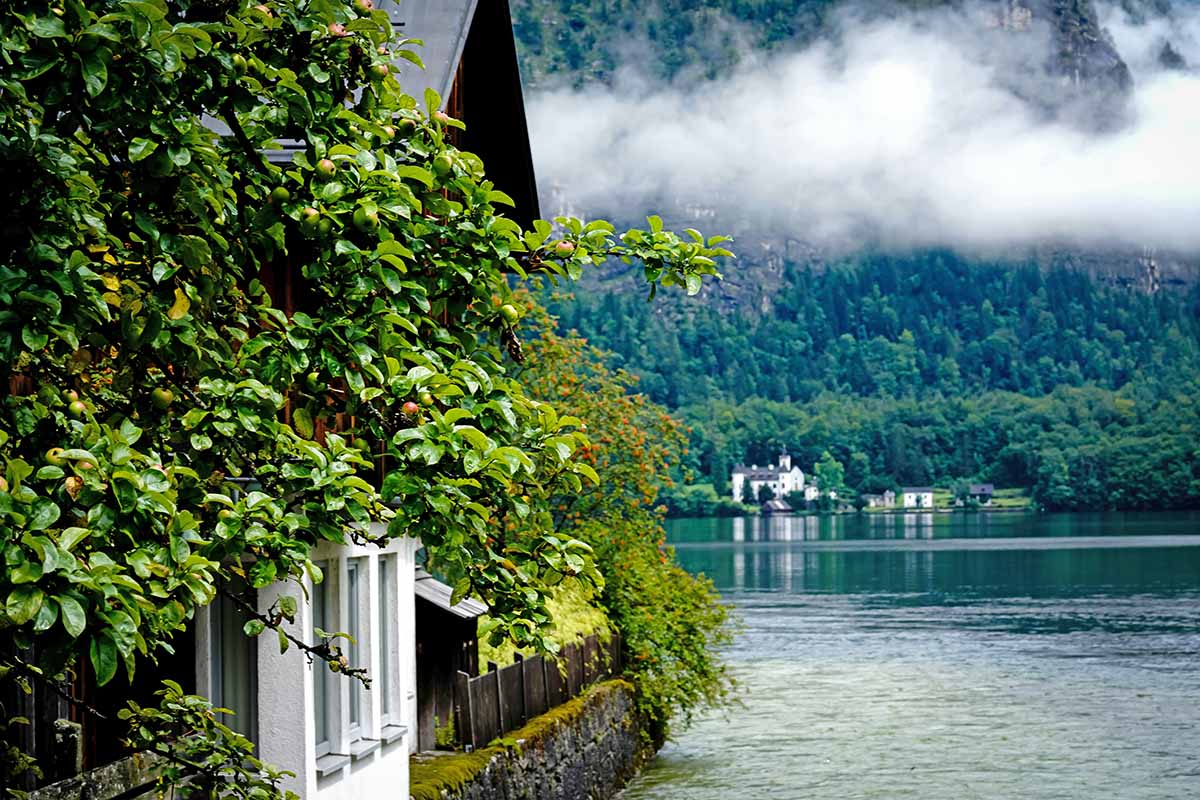
3. Boat Tours on Hallstätter See
A popular way to experience the lake is by taking a boat tour – classic ones depart from Hallstatt and Obertraun.
Whether you’re sipping espresso on a guided cruise or channelling your inner gondolier on a rented rowboat, gliding across the tranquil waters provides unparalleled panoramic views of the Dachstein Alps.
If you prefer a more active adventure, kayaking and stand up paddling (SUP) on Hallstätter See allow you to navigate the lake at your own pace and discover secluded coves.
4. Hiking around Hallstätter See
Hiking in the Hallstätter See region is a favorite pastime and a cultural rite, ranging from easy lakeside paths to heart-pounding mountain hikes with dramatic scenery.
Whatever your skill level, the Dachstein Giant Ice Cave and the Five Fingers viewing platform are must-visit attractions.
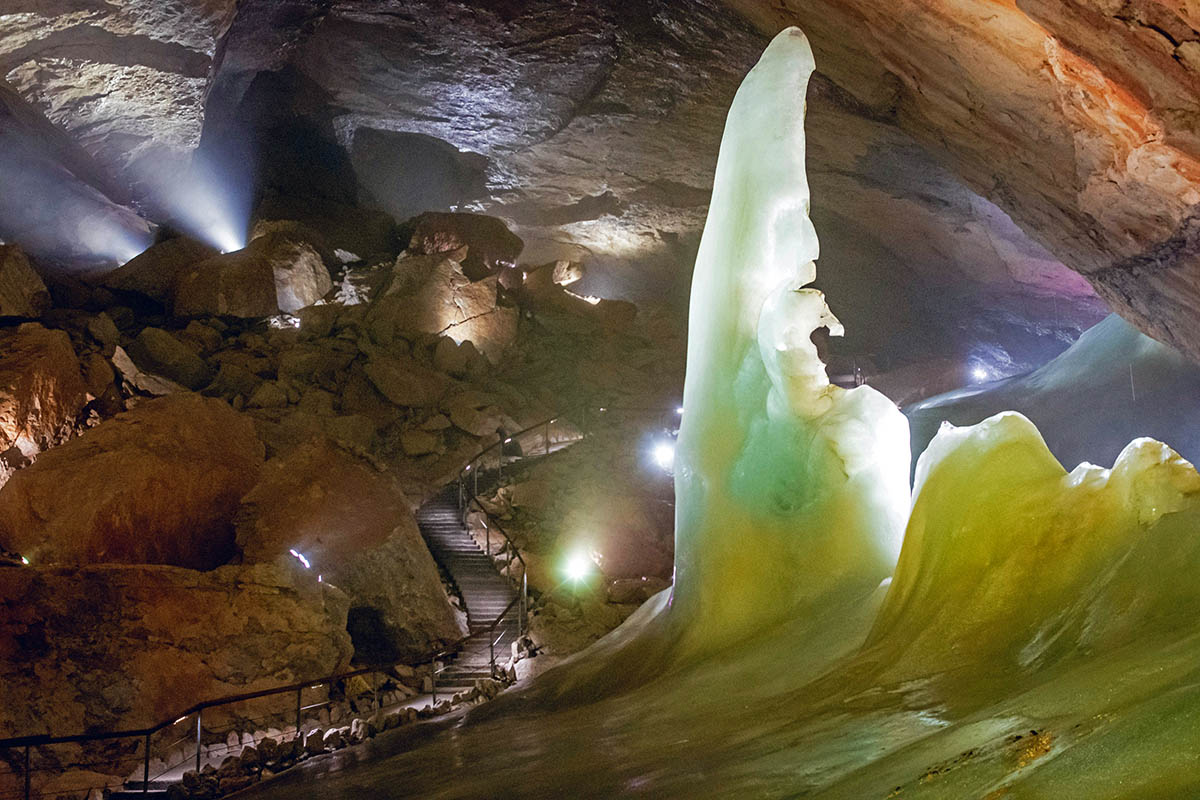
The Ice Cave, accessible via a Dachstein Krippenstein cable car from Obertraun (hop off at the Middle Station and take a 15-minute uphill walk), offers a surreal journey through a frozen wonderland of ice formations and glacial tunnels. A 50-minute tour guides you through surreal ice palaces, cold underground tunnels, and even over a rope bridge suspended above a 30-meter abyss.
For more adventure, continue to the Mammut Cave, one of the largest karst cave systems in the world. Out of 70 km of passageways, only a one-kilometer section is open to visitors, unlike, for instance, at nominally smaller Slovenia‘s Postojna Cave, whose sheer amount of accessible kilometers makes it the largest European show cave.
Hike onward to the Five Fingers, a hand-shaped observation deck hanging over the cliffside, 400 meters above Hallstätter See. The panoramic views will stretch as far as the eye can see.
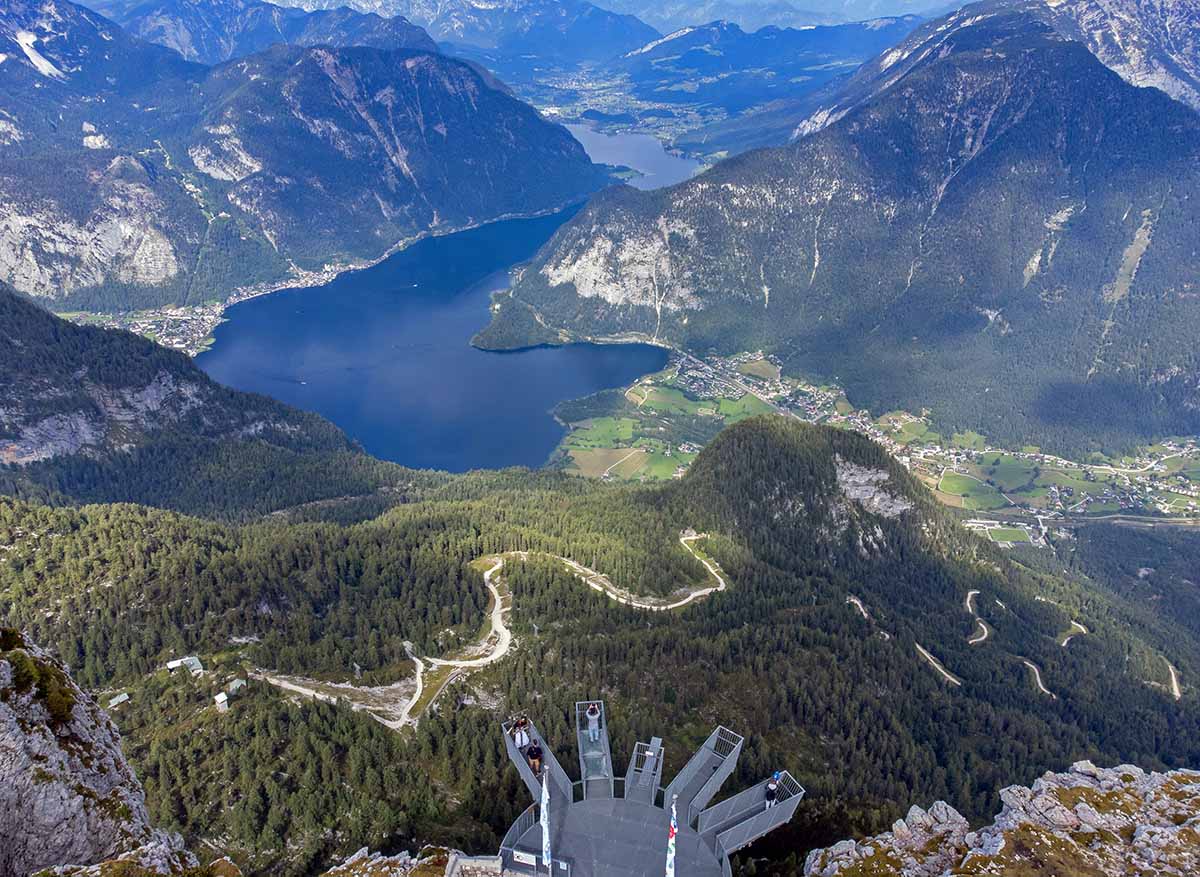
If you’re afraid of heights or enclosed spaces, there’s always a more relaxed hike down below. The circular trail around the lake (known as Hallstätter See Rundweg) lets you experience it from just about every angle. The length of the scenic hiking route is 23 kilometers, and you’d need at least 5 hours for the full loop. Bring a picnic.
If you decide on Hallstätter See Rundweg cycling, it should take 3.5 hours at a relaxed pace. Start in Hallstatt and head counterclockwise around the lake. This route combines the Ostuferradweg (East Shore Cycleway) – a quiet, lakeside trail – with sections on public roads along the west side. Early mornings and late afternoons offer better light and fewer crowds.
5. Klettersteig – Via Ferrata Challenge
Think you’ve got what it takes to conquer the Alps?
The Hallstätter See Klettersteig, better known as the Seewand Klettersteig, is the most challenging via ferrata (climbing route) in the region and one of the toughest in the entire Alpine arc. It clings to the dramatic Seewand cliffs above the southern end of Lake Hallstatt, offering unbeatable views and a serious adrenaline rush for seasoned climbers.
Its difficulty rating is D/E (very difficult), the elevation gain is 750 meters, and it could take you between 5 and 8 hours to finish (depending on pace and panic level). The route is extremely steep and exposed, with no emergency exits, and will test even the experienced climbers. Bring full via ferrata gear and peak physical fitness!
A word to the wise: many underestimate Seewand Klettersteig. Rescue operations are frequent, and you really don’t want to become a helicopter anecdote. So approach it with respect!
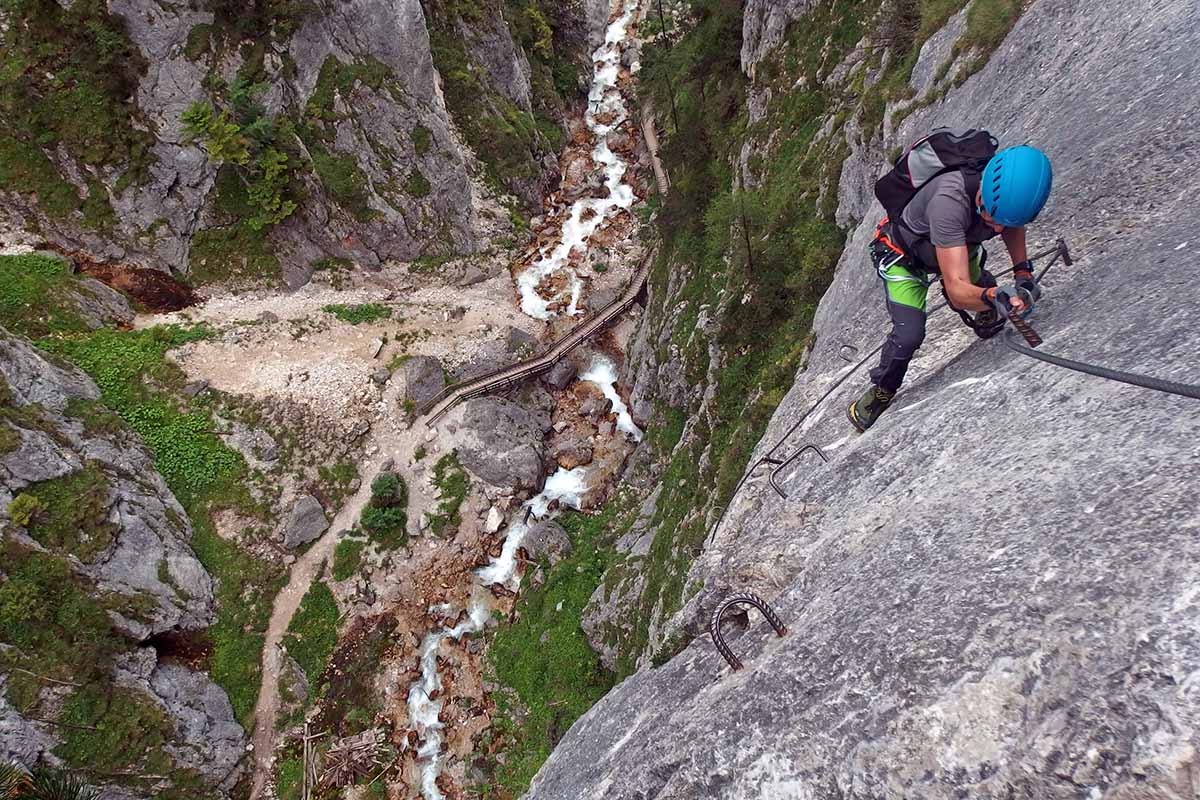
6. Hallstätter See paragliding
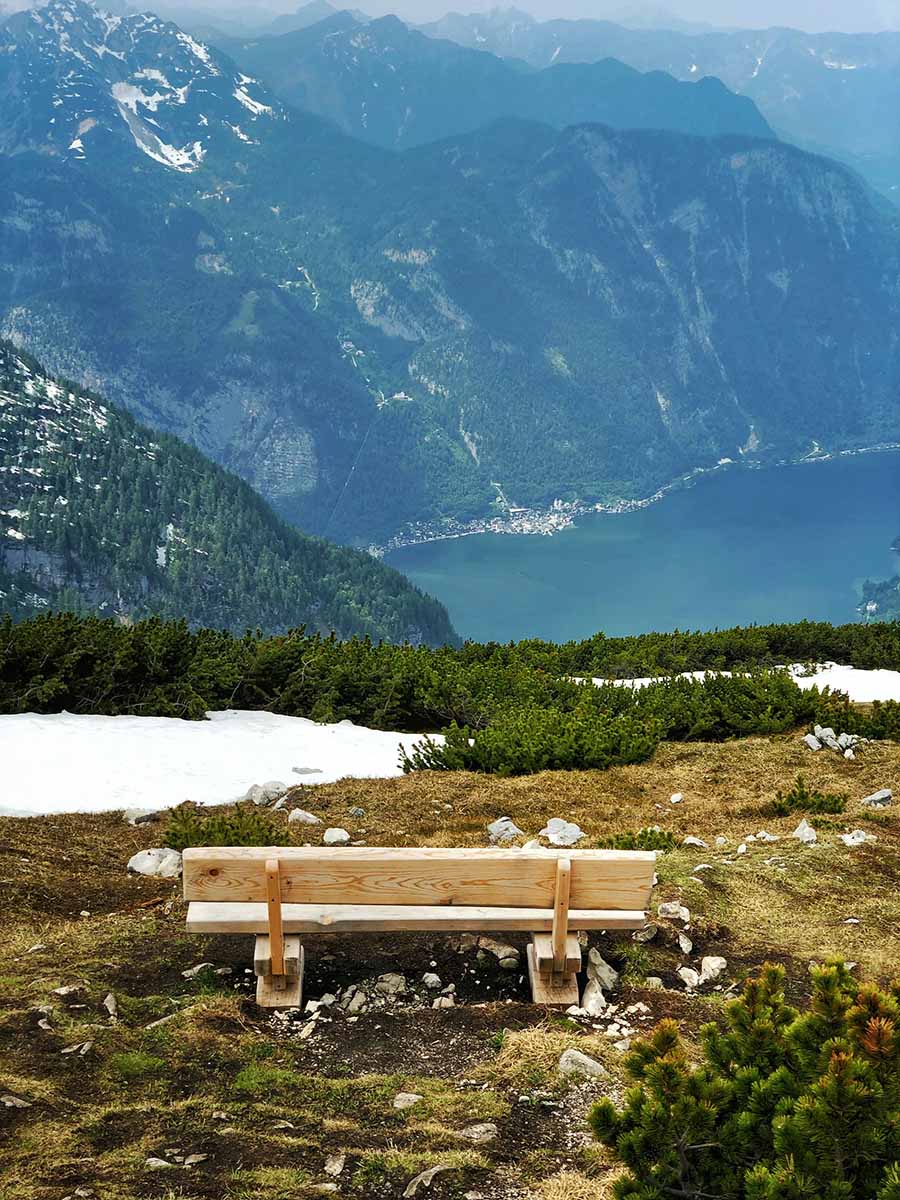
Who needs a drone when you can take to the skies? Paragliding over Hallstätter See is your chance to soar like an eagle, or at least float like a very excited human in a harness.
The adventure begins at Mount Krippenstein (2,100 m) above Obertraun. The launch site is just a 10-minute walk from the cable car’s mountain station. From here, it’s an easy take-off with a certified tandem pilot (exclusively available through Sky Club Austria).
You’ll drift over the Five Fingers viewing platform, taking in a jaw-dropping panorama of the Dachstein Massif and the entire Hallstätter See.
7. Visiting Salzwelten, the Hallstatt Salt Mine
History buffs love visiting the Salzwelten Hallstatt (Hallstatt Salt Mine) on Salzberg (Salt Mountain), one of the oldest in the world. Some of its tunnels may date back over 7,000 years.
The guided tours dig deep into the history of salt mining and its impact on the region, revealing how “white gold” powered the rise of Hallstatt long before it became selfie central.
You’ll visit the subterranean tunnels with Europe’s oldest wooden staircase (2,800 years old), have an insight into miners’ life at the Bronze Age Cinema, and ride a 64-meter-long miners’ slide.
To reach the Hallstatt Salt Mine, ride Salzbergbahn, a funicular that zips you from the valley up the mountain in minutes.
Note: As the funicular is under renovation until summer 2026, the only way up is via 800 stairs.
Once on top, in front of the historic Rudolfsturm Restaurant, you’ll find Hallstatt Skywalk, or World Heritage View, a free-floating observation deck that juts 12 meters out from the cliffside. It’s a spectacular vantage point for possibly the best view of Hallstätter See, the Dachstein Mountains, and Hallstatt’s iconic rooftops.
Nearby, you can also visit Schaugrab, a walk-in burial site that provides a privileged glimpse into ancient Hallstatt Culture death rituals.
See the Hallstätter See from above in my YouTube video made with a drone!
Best Time to Visit Hallstätter See
Wondering when to visit Hallstätter See? The best months to go to Hallstatt are typically considered May and June, with all summer months following. But Hallstätter See is a year-round destination, and each season brings its charm.
Spring, from April to June, is a wonderful time to visit as the region awakens from hibernation. The weather is mild, and the landscape bursts with blooming flowers and lush greenery. This is an ideal time for hiking, especially for those who wish to enjoy the trails without crowds.
Summer, from July to August, is the peak tourist season, but for good reason. The weather is warm, and the days are long, ideal for outdoor adventures, from hiking to mountain biking. Water sports are also popular during this time, while vibrant villages come alive with festivals and events. As this is the busiest time of the year, it’s essential to book accommodation in advance.
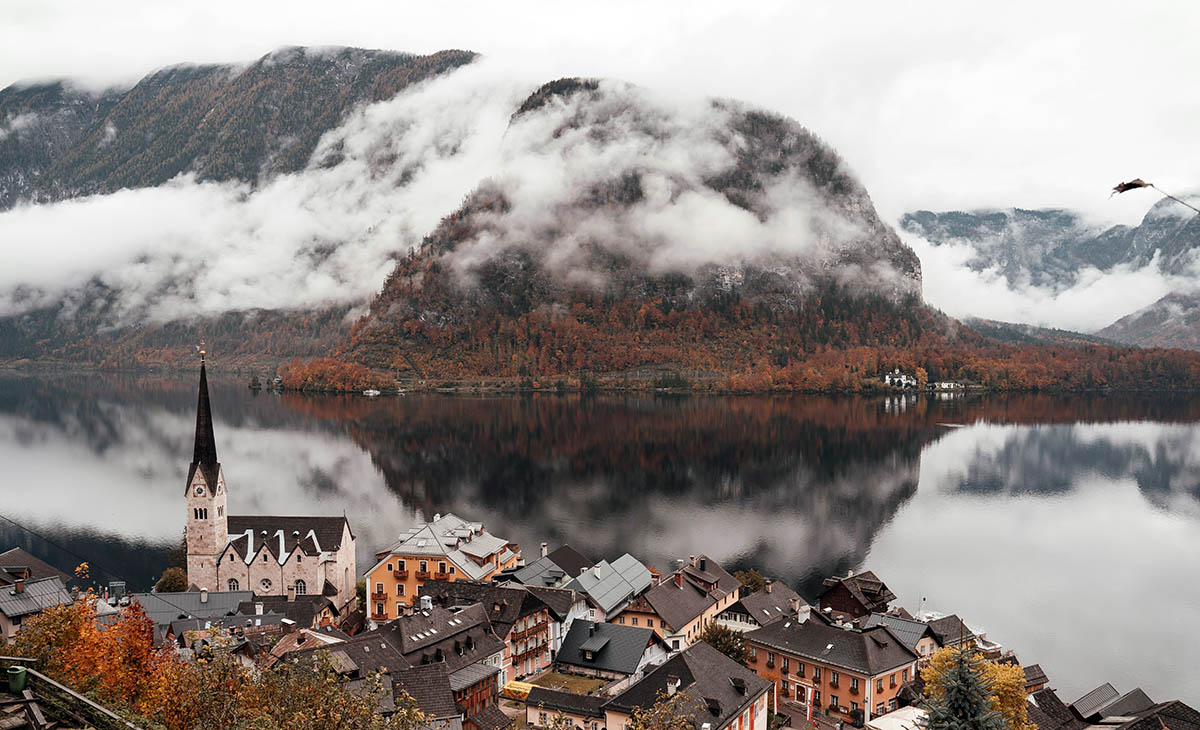
Autumn, especially September and October, is a magical period to visit Hallstätter See. The changing fall foliage paints the landscape in brilliant hues of red, orange, and gold, creating a stunning contrast against the blue waters of the lake. The weather is cooler, making it comfortable for outdoor activities, and the crowds begin to thin out, offering a more relaxed experience.
Winter, from December to February, transforms Hallstätter See into a snowy wonderland. The Christmas markets, alpine chalets, and twinkling lights add a festive charm, making it a delightful time to visit. For winter sport lovers (from skiing and snowshoeing to ice swimming), this is a magical destination.
Parts of Hallstätter See in winter do freeze (mostly the northern section, away from the river Traun). However, ice skating directly on the lake isn’t officially managed, and thin ice can be deceptive and dangerous. Better stay on shore and reflect on the old Disney rumor: Did Hallstatt inspire “Frozen”?
Tips for exploring Hallstätter See
With the right tips and preparations, exploring Hallstätter See can be an unforgettable experience. Consider this:
- Pack according to the season. Each season offers unique opportunities and activities, so consider what you want to experience and pack accordingly. Comfortable walking shoes and layered clothing are always recommended. You’ll also want weather-specific extras, depending on your plans (swimwear, gloves, or a raincoat).
- Mix and match transport options. To get the most out of your Hallstätter See visit, taking advantage of various modes of transportation is a smart choice. Walking and hiking are great ways to access quieter corners, renting a bicycle allows you to cover more ground, while boats and ferries provide a different perspective of the lake. Use public transport whenever possible, as Hallstatt can be a parking nightmare.
- Stay thoughtful. With Hallstatt’s ever-growing popularity, it’s essential to behave responsibly in order not to jeopardize its charm. Respect local signs and quiet zones, especially near homes. Stick to marked trails while hiking, avoid trampling nature for a selfie, be mindful of wildlife, and dispose of waste properly. Support eco-conscious accommodations and businesses, and avoid single-use plastics.
- Don’t overdo it with photography. At one of the most photographed places in Europe, capturing memories with a camera is kind of expected. But it is also important to take moments to simply enjoy the beauty of Hallstätter See without the urge to document every swan. To not contribute to the crowding, get up early, and enjoy the privilege of capturing the sights in the best light.
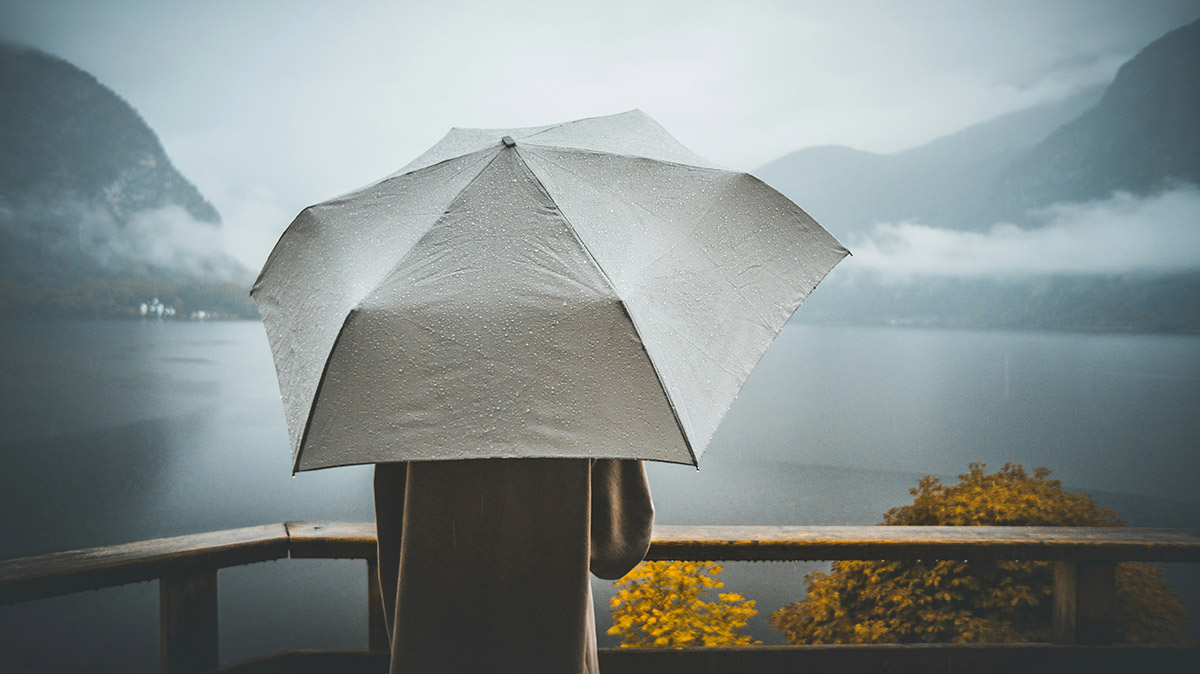
How to Get to Hallstätter See
Located in the northern Austrian Alps, about 1 hour southeast of Salzburg and 2.5 hours west of Vienna, reaching Hallstätter See is quite straightforward and simple.
- By air: The nearest major Austrian airports are in Salzburg (approx. 75 km) and Vienna (approx. 280 km). Another option is to fly into Munich, Germany (approx. 220 km). From any of these airports, continue by train or car to reach the lake region.
- By train: The scenic train journey from Salzburg or Vienna leads to Bad Ischl or Attnang-Puchheim, where you can transfer to a local bus to Hallstatt, or a train to Hallstatt Bahnhof (the station on the opposite side of the lake). A short ferry ride across Hallstätter See takes you directly into the village.
- By car: Drive through the winding roads of the Austrian countryside with rewarding views. Parking is limited and pricey in Hallstatt, so plan accordingly.
Hotels Near Hallstätter See
Where to stay near Hallstätter See? Hallstatt and its surrounding areas offer a variety of accommodation options to suit different preferences and budgets.
-
- Luxury: Heritage Hotel Hallstatt in the heart of the old town offers lake views, modern comforts, and historic charm. Available on Booking, Agoda, Trip, or Expedia.
- Mid-range: Seehotel Grüner Baum combines classic Austrian elegance, hearty breakfasts, and views worth waking up early for. Reserve your room directly on Booking, Agoda, Trip, or Expedia.
- Budget: This area is hardly a budget backpacker mecca. But guesthouses in less trending towns like Obertraun offer more affordable options with easy access.
For instance, Camping Park am See is a quirky collection of unique, restored vintage trailers. You might fall in love just by looking at them. Check them out on Booking or Agoda.
Another Obertraun option is Seehotel am Hallstättersee, a family-oriented place with a pool and kids’ playground. You can see this option on Booking, Agoda, or Trip.
In Bad Goisern, a well-located and even more wallet-friendly base is the Good-Goisern Hotel. Compare rates for your dates on Booking and Agoda.
If your budget and booking luck allow, try to stay right on the lake’s edge for the most immersive experience.
Hallstätter See, Austria – Conclusion
For me, Hallstätter See was sadly just a quick pause, a roadside attraction on my journey from Central to Southern Europe. Given more time, I can see how easily this mirror-like lake, surrounded by alpine adventures and storybook villages, could charm you into a much longer stay. How refreshing would it feel to immerse oneself in this beautiful stopover for an entire week!
Hallstätter See feels like an intimate variation of a Nordic fjord
Days spent in leisurely strolls or exhilarating hikes, uncovering the area’s rich history and cultural surprises, would make your thoughts drift away into the mysteries and intrigues of this enchanting Austrian corner.
Lake Hallstatt’s sunken forests and silent shipwrecks, salt-rich gateways to the underworld of the mountains, and a chapel filled with painted skulls – it can all fuel your imagination as you observe misty mornings from steep shores.
No, Hallstatt probably wasn’t the blueprint for Elsa‘s royal home of Arendelle. The official design inspiration credits Akershus Fortress in Oslo, Norway. But Hallstätter See does feel like an intimate variation of a Nordic fjord.
Despite just being a whispering version of a natural amphitheater, Lake Hallstatt still comes with a similar sense of otherworldliness and timelessness, its grand Scandinavian cousins are known for.
Yes, it’s beautiful. Yes, it’s busy. And yes, Hallstätter See is absolutely worth it.
Do you like Hallstätter See?
Pin this article for later!
Disclosure: This post may contain affiliate links, meaning if you click on them and make a purchase, Pipeaway may make a small commission, at no additional cost to you. Thank you for supporting our work! The photographs in this article have been sourced through Unsplash. In the order of appearance, the authors are as follows: Hallstatt panorama - Ljubomir Žarković Boat and swans - Benjamin Kaufmann Church steeple - Antonis Tsatas Houses - Free Walking Tour Salzburg Apple tree - Daniela Holzer Ice cave - Sandra Grünewald Five Fingers - Ben Michel Via ferrata Rosina - Maja Kochanowska Bench view - Victor Malyushev Hallstatt in autumn - Alex Foret Umbrella - Çağlar Canbay Mountain view of the lake (pin image) - Tatiana Rudneva

